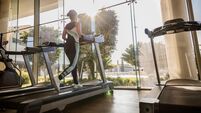How to strengthen your heart with a brisk walking routine

Walking at a fast pace strengthens the heart, lowers harmful cholesterol, and helps maintain a healthy weight.
Could simply picking up the pace on your daily walk be the secret to a healthier heart?
Research from the University of Glasgow suggests that walking briskly might do more than just boost your mood— it could significantly lower your risk of developing serious heart rhythm issues.
The study, published in , analysed data from more than 420,000 people.
Participants self-reported their walking pace as either slow (under 5km/h), average (5-6km/h), or brisk (over 6km/h). After adjusting for demographic and lifestyle factors, the researchers found that those who walked at an average pace had a 35% lower risk of heart rhythm issues, while brisk walkers saw a 43% reduction — compared to slow walkers.
Consultant cardiologist Oliver Guttmann talks about the benefits of brisk walking and shares some practical tips on how to make it part of your daily routine.
What does brisk walking mean in terms of pace or heart rate?
“Brisk walking means walking at a pace that makes your heart beat faster and gets your body working harder,” says Guttmann.
“When you walk briskly, your heart needs to pump more blood to supply your muscles with the extra oxygen they need — which causes your heart rate to increase.
"You’ll notice that you’re breathing a bit faster, but you should still be able to talk. You’re slightly out of breath, but not struggling.”
What happens to the cardiovascular system during brisk walking? Why is it better than normal walking?
“During brisk walking, your heart beats faster to pump more oxygen-rich blood to your muscles,” Guttmann says.
“This strengthens the heart, improves circulation, and helps keep your blood vessels healthy.
“Brisk walking also encourages the heart to become more efficient, meaning it doesn’t have to work as hard during everyday activities.
“The faster pace also supports better circulation and metabolism.”
This is different from a gentle walk, where your heart rate stays steady and doesn’t increase much.
“A slow walk doesn’t challenge your heart enough to make it stronger or improve circulation,” says Guttmann.
“Brisk walking, however, provides enough of a challenge for your cardiovascular system, helping it become stronger.”
Brisk walking can also help lower blood pressure and cholesterol levels.
“Regular brisk walking improves circulation and helps your heart work more efficiently, which can lead to a reduction in blood pressure over time,” says Guttmann.
“It also helps increase the level of good cholesterol (HDL) while lowering bad cholesterol (LDL) and reducing fat build-up in the blood vessels. These effects reduce strain on the heart and improve cardiovascular health.
“Additionally, brisk walking helps manage blood sugar levels — which is important for reducing the risk of diabetes, a key factor in heart disease, high blood pressure, and cholesterol problems.”
Can it help reduce the risk of heart disease and stroke?
“Yes, brisk walking can significantly reduce the risk of heart disease and stroke,” confirms Guttmann.
“It strengthens the heart, lowers harmful cholesterol, reduces blood pressure, and helps maintain a healthy weight — all crucial factors in preventing cardiovascular disease and stroke.
“Brisk walking also reduces inflammation in the body, keeps arteries flexible, and prevents plaque from building up in the arteries — which can block blood flow and lead to heart attacks or strokes.”
How often and how long should someone walk briskly to see measurable heart benefits?
“To see heart health benefits, aim for at least 150 minutes of brisk walking per week — which is roughly 30 minutes a day, five days a week,” advises Guttmann.
“This amount of activity has been shown to lower blood pressure, improve cholesterol levels, and strengthen the heart.
“If finding 30 minutes in one go is challenging, you can break it into shorter sessions even three 10-minute walks throughout the day will still provide benefits.”
How can someone make brisk walking part of their routine?
“Start by walking to the shops instead of driving, taking the stairs instead of the lift, or getting off the bus or train a stop early and walking the rest of the way,” recommends Guttmann.
“You could also use your lunch break to go for a walk, or make it a social activity by walking with a friend or family member.
“Setting a daily step goal or incorporating walking into your commute can help turn it into a habit.
“The more you make it part of your lifestyle, the easier it becomes to stick with,” he says.

Celebrating 25 years of health and wellbeing










